
In physics and mechanics, torque is the rotational analogue of linear force. It is also referred to as the moment of force. The symbol for torque is typically , the lowercase Greek letter tau. When being referred to as moment of force, it is commonly denoted by M. Just as a linear force is a push or a pull applied to a body, a torque can be thought of as a twist applied to an object with respect to a chosen point; for example, driving a screw uses torque, which is applied by the screwdriver rotating around its axis. A force of three newtons applied two metres from the fulcrum, for example, exerts the same torque as a force of one newton applied six metres from the fulcrum.
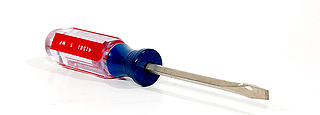
A screwdriver is a tool, manual or powered, used for turning screws.
A torque wrench is a tool used to apply a specific torque to a fastener such as a nut, bolt, or lag screw. It is usually in the form of a socket wrench with an indicating scale, or an internal mechanism which will indicate when a specified (adjustable) torque value has been reached during application.

Torx is a trademark for a type of screw drive characterized by a 6-point star-shaped pattern, developed in 1967 by Camcar Textron. A popular generic name for the drive is star, as in star screwdriver or star bits. The official generic name, standardized by the International Organization for Standardization as ISO 10664, is hexalobular internal. This is sometimes abbreviated in databases and catalogs as 6lobe. Torx Plus,Torx Paralobe and Torx ttap are improved head profiles.

Carbon steel is a steel with carbon content from about 0.05 up to 2.1 percent by weight. The definition of carbon steel from the American Iron and Steel Institute (AISI) states:

A fastener or fastening is a hardware device that mechanically joins or affixes two or more objects together. In general, fasteners are used to create non-permanent joints; that is, joints that can be removed or dismantled without damaging the joining components. Steel fasteners are usually made of stainless steel, carbon steel, or alloy steel.

A bolted joint is one of the most common elements in construction and machine design. It consists of a male threaded fastener that captures and joins other parts, secured with a matching female screw thread. There are two main types of bolted joint designs: tension joints and shear joints.

A socket wrench is a type of spanner that uses a closed socket format, rather than a typical open wrench/spanner to turn a fastener, typically in the form of a nut or bolt.
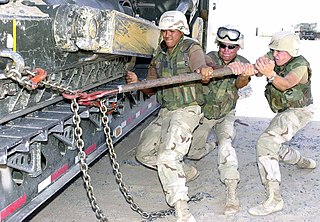
A cheater bar, snipe, or cheater pipe is an improvised breaker bar made from a length of pipe and a wrench (spanner).
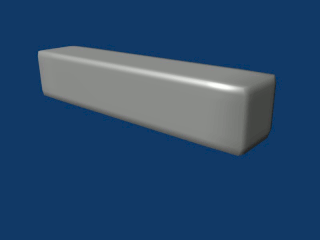
In the field of solid mechanics, torsion is the twisting of an object due to an applied torque. Torsion is expressed in either the pascal (Pa), an SI unit for newtons per square metre, or in pounds per square inch (psi) while torque is expressed in newton metres (N·m) or foot-pound force (ft·lbf). In sections perpendicular to the torque axis, the resultant shear stress in this section is perpendicular to the radius.
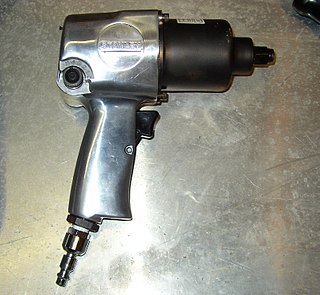
An impact wrench is a socket wrench power tool designed to deliver high torque output with minimal exertion by the user, by storing energy in a rotating mass, then delivering it suddenly to the output shaft. It was invented by Robert H. Pott of Evansville, Indiana.

An impact driver is a tool that delivers a strong, sudden rotational force and forward thrust. The force can be delivered either by striking with a hammer in the case of manual impact drivers, or mechanically in the case of powered impact drivers.

The screw is a mechanism that converts rotational motion to linear motion, and a torque to a linear force. It is one of the six classical simple machines. The most common form consists of a cylindrical shaft with helical grooves or ridges called threads around the outside. The screw passes through a hole in another object or medium, with threads on the inside of the hole that mesh with the screw's threads. When the shaft of the screw is rotated relative to the stationary threads, the screw moves along its axis relative to the medium surrounding it; for example rotating a wood screw forces it into wood. In screw mechanisms, either the screw shaft can rotate through a threaded hole in a stationary object, or a threaded collar such as a nut can rotate around a stationary screw shaft. Geometrically, a screw can be viewed as a narrow inclined plane wrapped around a cylinder.
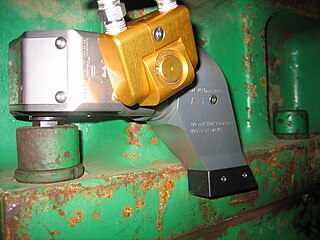
A hydraulic torque wrench is a power tool designed to exert torque on a fastener to achieve proper tightening or loosening of a connection through the use of hydraulics. A torque wrench is applied to the nut either directly or in conjunction with an impact socket. Hydraulic torque wrenches apply a predetermined, controlled amount of torque to a properly lubricated fastener.

A screw is an externally helical threaded fastener capable of being tightened or released by a twisting force (torque) to the head. The most common uses of screws are to hold objects together and there are many forms for a variety of materials. Screws might be inserted into holes in assembled parts or a screw may form its own thread. The difference between a screw and a bolt is that the latter is designed to be tightened or released by torquing a nut.

A nut is a type of fastener with a threaded hole. Nuts are almost always used in conjunction with a mating bolt to fasten multiple parts together. The two partners are kept together by a combination of their threads' friction, a slight stretching of the bolt, and compression of the parts to be held together.

A torque multiplier is a tool used to provide a mechanical advantage in applying torque to turn bolts, nuts or other items designed to be actuated by application of torque, particularly where there are relatively high torque requirements.

A bolt is an externally helical threaded fastener that fastens objects with unthreaded holes together. This is done by applying a twisting force (torque) to a matching nut. The bolt has an external male thread requiring a matching nut with a pre-formed female thread. Unlike a screw, which holds objects together by the restricting motion parallel to the axis of the screw via the normal and frictional forces between the screw's external threads and the internal threads in the objects to be fastened, a bolt prevents that linear motion via the frictional and normal forces between the bolt's external threads and the internal threads of the matching nut, which can be tightened by applying a torque which moves the nut linearly along the axis of the bolt and compresses the objects to be fastened.
Amount of the no-load tension in the bolted joint (preload) greatly affects the reliability of the joint. Multiple techniques exist for preload control to ensure that the tension in the bolt is close to the one specified in the design :
















